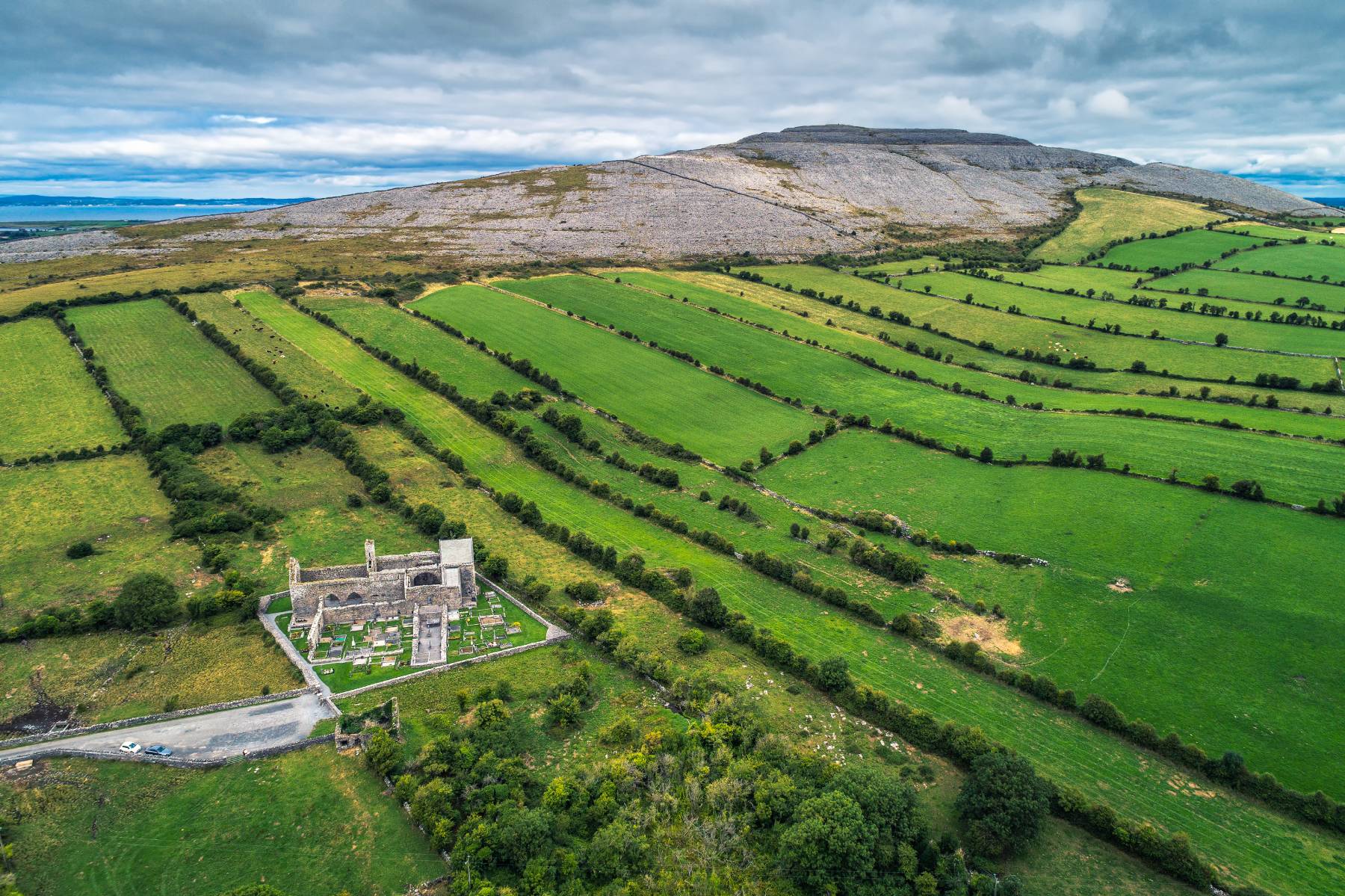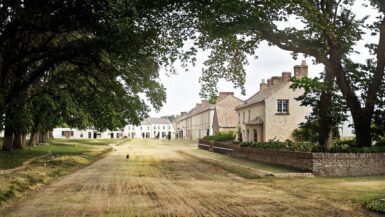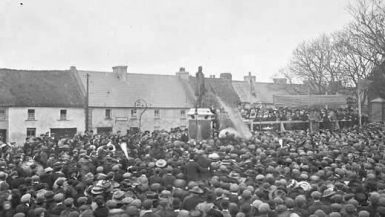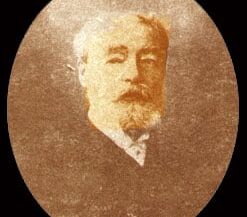Nestled in the rolling hills of County Clare, near Ballyvaughan, lies the abandoned ruins of Corcomroe Abbey. Founded in in 1190, this once-grand abbey is now a forgotten piece of history, known only to the few who take the time to seek it out.
Corcomroe Name
The abbey takes its name from Corco Mrua (meaning “seed” or “kernel” of Muaidhe), referring to Corco Modhruadh Iartharach (Muaidhe), which relates the origin myth of Corcomroe’s ruling family. Corco Mrua was also sometimes referred to as Corca Bruithnig (meaning “sons/descendants of [the god] Breogan”).
Corcomroe Abbey is located in Corcomroe, which according to the “Annals of the Four Masters” was founded by Murchadh Carrach Ó Briain. Corco Modhruadh Iartharach (Muaidhe), which relates the origin myth of Corcomroe’s ruling family, tells that Corcomroe was named after Corpre Cruim Rechta who lived during the reign of Breanainn mac Feidlimid (died 483 AD) when he and his wife Corca Modhruadh (also Muireann ingen Choncraind and Dúnlang daughter of Conaing son of Dubthach moccu Lughair) lived in this area.
According to Corco Modhruadh Iartharach (Muaidhe), Corcomroe owed its name to Corpre Cruim Rechta, the leader of a group of sixty families that set out from north Connacht. Corpre’s son was Corb Olom who is said to have built Rath Melsigi which later became the site of Moynoe churchyard. Corpre Cruim Rechta’s son was Corbmac mac Corpre who built a fort at Cragbrien. The fort was called Dúnad Lethglaise (“Fort of Death”) because Munster king Conghalach Ó Briain burned his brother Aengus there in 1159 AD.
After the death of Corbmac Corpre the territory of Corcomroe was divided among his six sons. Corcomroe North went to Corb’s son Eoghan, Corcomroe South went to Aedh Buidhe who built Rath Cromghlinne and gave his name to Corcomroe townland. The result is that Corcomroes are scattered over three baronies in north County Clare – Bunratty Lower, Bunratty Upper, and Corcomroe.
The monastery at Corcomroe is first mentioned by the annals for 1252 AD which notes the death of “A friar Minor of St Francis” named Tadhg O hOgain there. In 1320 AD an English official complained about raids on Corcomroe monastery. Corcomroe became a house of Augustinian Canons Regular sometime after 1320 AD, likely in the reign of King Donnchad Ó Briain (ruled 1194-1242).
By 1374 Corcomroe Abbey was wealthy enough that it owned four cartloads of books according to an Inquisition for the Archdiocese of Tuam held by papal commissioner John de Trillek, Bishop of Limerick. Corcomroe also had over ten cartloads worth of chalices and other items by 1416 AD. The monastery at Corcomroealso controlled 41 churches in three dioceses – Annaghdown, Tuam, Clonfert – 13 more than Clonfert’s own holdings. Corcomroe was one of the few Irish abbeys to hold prebends (a stipend paid in exchange for services) and Corcomroe had at least eight, including Kilnasoolagh, Killuran and Ballysakeery in the diocese of Annaghdown; Kilgarraun and Muckanaghederdauhaulia in Tuam; Clonfert, Leamaneh, Aghagower, Ballintober and Kiltullagh in Clonfert. Corcomroe also had responsibilities overseeing St Brigid’s Church in Liscannor.
Between 1320 AD-1347 AD Corcomroe Abbey was raided on average once per decade. In 1320 Corcomroe was raided by the Anglo-Irish de Clare family, thus prompting Corcomroe to build a bawn with battlements. In 1347 Corcomroe Abbey was attacked at night and the besiegers attempted to undermine its walls with pickaxes but Corcomroe’s canons managed to drive them off. Corcomroe Abbey was attacked for a third time in 1463 AD when it paid £40 “for not being burnt”.
The abbey of Corcomroe had a small college of six clergy by 1532. By 1645 there were nine priests administering forty-five churches from Corcomroe according to the Acta Sanctorum Hiberniae (diary of Friar John Colgan). Corcomroe Abbey itself had only three canons by 1645.
The tombs of most of Corcomroe’s abbots are in Temple Cronan with the exception of Maurice O’Brien (abbot 1532-1551) who is buried in Kilnasoolagh churchyard. The current parish church at Corcomroe is dedicated to St Catherine but Corcomroe previously had seven other churches within its territory – Teampul Conaire (dedicated to St Coirpre), Teampul Maille (St Mel), Aughinish, Killurin, Cill Imchomair (Cill Umchomair), Rath Melsigi and Ballylennin.
The Franciscan friars who Corcomroe gave hospitality to during the 1651 Rebellion stayed on at Corcomroe for some time afterwards. By 1750 there were no longer any resident clergy in Corcomroe but it continued to be served by priests from Templecrone parish out of necessity. By 1837 Corcomroe was united with Rathborney parish according to Griffith’s valuation. The present Catholic church at Corcomroe is dedicated to St. Catherine of Alexandria and was built in 1841.
John O’Donovan visited Corcomroe in 1839 and noted that the old Abbey was in bad shape. Half of its roof had collapsed, the abbey’s walls were crumbled, and most of Corcomroes ecclesiastical relics (such as their illuminated manuscripts) had been sold by the impoverished canons.

Corcomroe Abbey today
Today Corcomroe Abbey site is occupied by Corcomroe Abbey GAA club which has its clubhouse on the site as well as Corcomroe National School which also occupies space within Corcomroe Abbey’s walls. Corcomroe Abbey churchyard contains a memorial stone for those massacred at nearby Kilnasoolagh church in 1645 AD as well as a 17th-century sundial mounted on an early medieval cross-base.
Corcomroe Abbey Churchyard contains a memorial stone for those massacred at nearby Doon Well (“Tobar an Ughait”) during the 1645 massacre of Irish Catholics ordered by Cromwell. Corcomroe Abbey GAA club have built a clubhouse on the site as well as Corcomroe National School which also occupies space within Corcomroe Abbey’s walls. Corcomroes sister parish Rathborney church stands 2km to the south-west from Corcomroes current location overlooking Lough Bunny Bay between Connaford Point and Inch Point. Corcomroe Abbey churchyard contains a memorial stone for those massacred at nearby Kilnasoolagh church in 1645 AD as well as a 17th-century sundial mounted on an early medieval cross-base.
Despite its relative obscurity, Corcomroe Abbey is a must-visit for anyone interested in Ireland’s rich history and cultural heritage. Its quiet, isolated location makes it a peaceful escape from the hustle and bustle of modern life, and its preserved ruins offer a glimpse into the lives of Ireland’s medieval monks.






Leave a reply